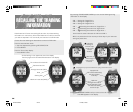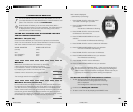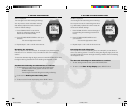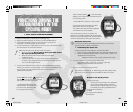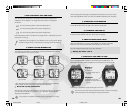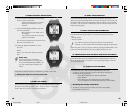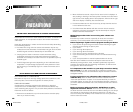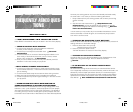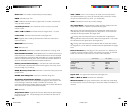
4140
2. Move the Receiver around until you find an area in which it displays no
stray reading or flashing of the heart symbol. Interference is often worst
right in front of the display panel of the equipment, while the left or right
side of the display is relatively free of disturbance.
3. Put the transmitter back on the chest and try to keep the wrist receiver
in this interference free area.
4. If the Polar Heart Rate Monitor still does not work with the exercise
equipment, this piece of equipment may be electrically too noisy for
wireless heart rate measurement.
Minimising possible risks in exercising with a heart rate
monitor
Exercise may include some risk, especially for those who have been
sedentary. To minimise possible risks consider the following advice:
Before beginning a regular exercise program consult your doctor
• if you are over 40 years of age and have not been following a regular
exercise program during the past 5 years
• if you smoke
• if you have high blood pressure
• if you have high blood cholesterol
• if you have any signs or symptoms of any disease
• if you are recovering from a serious illness or a medical treatment e.g.
surgery
• if you use a pacemaker or another implanted electronic device.
Note also that in addition to exercise intensity the heart rate can be
affected by, amongst others, heart, circulation (particularly high blood
pressure) and asthma and other breathing medications, as well as some
energy drinks, alcohol and nicotine.
It is important to be sensitive to your body’s reactions during
the exercise. If you feel unexpected pain or tiredness regarding your
exercise intensity level, it is recommended to stop the exercise or continue
at a lighter intensity.
If you are allergic to any substance that comes into contact
with the skin, check the Polar heart rate monitor materials from the
“Technical specifications” chapter. It is recommended that you wear the
transmitter against your bare skin to ensure flawless operation. However, if
you wish to wear the transmitter over a shirt, moisten the shirt well under the
electrodes.
Notice to persons with pacemakers, defibrillator or other
implanted electronic device. Persons who have a pacemaker use
the Polar heart rate monitor at their own risk. Before starting use, we always
recommend an exercise test under doctor’s supervision. The test is to
ensure the safety and reliability of the simultaneous use of the pacemaker
and the heart rate monitor.
PRECAUTIONS
POLAR HEART RATE MONITOR IN A WATER ENVIRONMENT
Polar Protrainer XT receiver is water resistant to 20 metres. To maintain the
water resistance, do not operate the buttons of the Polar wrist receiver
under water.
Heart rate measurement in a water environment is technically demanding
for the following reasons:
• Pool water with a high chlorine content and seawater may be very
conductive and the electrodes of a transmitter may get short circuited
and ECG signals cannot be detected by the transmitter unit.
• Jumping into the water or strenuous muscle movement during
competitive swimming may cause water resistance that shifts the
transmitter on the body to a location where it is not possible to pick up
the ECG signal.
• The ECG signal strength varies depending on the individual’s tissue
composition. The percentage of people who have problems in heart
rate measuring is considerably higher in a water environment than in
other use.
POLAR HEART RATE MONITOR AND INTERFERENCE
ELECTROMAGNETIC INTERFERENCE
Disturbances may occur near high voltage power lines, televisions, cars,
bike computers, some exercise equipment or cellular phones.
EXERCISE EQUIPMENT
Several pieces of exercise equipment with electronic or electrical
components such as LED displays, motors and electrical brakes may
cause interfering stray signals. To try to tackle these problems, relocate the
Polar wrist receiver as follows:
1. Remove the transmitter from your chest and use the exercise equip-
ment as you would normally.
PROXT GBR/E 7.2.2001, 09:0140-41



